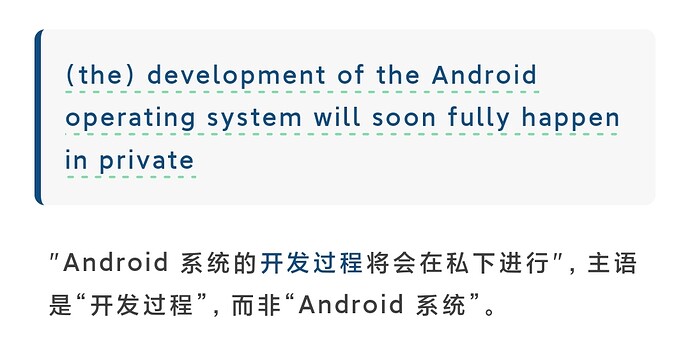总结
Google is making a sweeping structural change to the development of Android, confirming this week that all work on the operating system will now take place exclusively behind closed doors. Beginning next week, Google will shift the full development of Android OS into its private internal branches, ending its long-standing hybrid model that allowed for limited public transparency through the Android Open Source Project (AOSP).
谷歌正在对 Android 的开发进行全面的结构性改革,本周确认操作系统的所有开发工作将完全闭门进行。从下周开始,谷歌将把 Android 操作系统的全面开发转移到其私有的内部分支,结束其长期以来通过 Android 开源项目 (AOSP) 实现有限公开透明度的混合模式。
The announcement, first reported by Android Authority, marks a historic shift for the mobile industry’s most widely used operating system. “All Android development will occur within Google’s internal branches,” the company told the outlet. While the company maintains that Android will remain open source, developers and observers will no longer have access to ongoing changes until new versions are formally released.
该公告由 Android Authority 率先报道,标志着移动行业使用最广泛的操作系统发生历史性转变。该公司告诉媒体:“所有 Android 开发都将在谷歌内部分支机构进行。”虽然该公司坚持认为 Android 将保持开源,但在新版本正式发布之前,开发人员和观察员将无法再访问正在进行的更改。
For more than 16 years, Android has operated on a dual-branch model, with the public AOSP branch serving as a permissively licensed, modifiable framework under the Apache 2.0 License. This model enabled third-party contributions and allowed manufacturers such as Samsung to build custom user interfaces, like One UI, on top of the core Android architecture. But most core components-including the OS framework-have long been developed internally at Google, with only certain modules like the Bluetooth stack and parts of the Linux kernel remaining publicly visible.
16 年来,Android 一直采用双分支模式,其中公共 AOSP 分支是 Apache 2.0 许可下的宽松许可、可修改框架。该模式允许第三方做出贡献,并允许三星等制造商在核心 Android 架构之上构建自定义用户界面(如 One UI)。但大多数核心组件(包括操作系统框架)早已在 Google 内部开发,只有某些模块(如蓝牙堆栈)和部分 Linux 内核仍然公开可见。
This dual-branch setup has resulted in chronic synchronization issues between AOSP and Google’s internal builds, often requiring developers to merge conflicting patches manually. For instance, a patch enabling screen magnifier features conflicted between the two branches due to differences in the accessibility settings file. Similarly, implementation of Android’s unlocked-only storage area API required cherry-picking and reconciliation of internal flags into AOSP.
这种双分支设置导致 AOSP 和 Google 内部版本之间存在长期同步问题,通常需要开发人员手动合并冲突的补丁。例如,由于辅助功能设置文件存在差异,一个启用屏幕放大镜功能的补丁在两个分支之间发生冲突。同样,Android 的仅解锁存储区域 API 的实现需要挑选和协调内部标志到 AOSP。
According to Google, streamlining into a single development track will eliminate these persistent merge conflicts. Developers familiar with trunk-based workflows will recognize this shift as an attempt to align Android’s platform evolution with faster iteration and tighter version control.
据 Google 称,精简为单一开发轨道将消除这些持续存在的合并冲突。熟悉基于主干的工作流程的开发人员会认识到这一转变是为了让 Android 平台的发展与更快的迭代和更严格的版本控制保持一致。
- Dual-branch AOSP/internal model ends next week
双分支 AOSP/内部模型将于下周结束
- Core Android OS features will no longer be developed in public
Android 操作系统的核心功能将不再公开开发
- Source code will be released only when major versions are finalized
仅当主要版本最终确定后才会发布源代码
- App developers unaffected; custom ROM and platform developers may face delays in access
应用程序开发人员不受影响;自定义 ROM 和平台开发人员可能会面临访问延迟
The move will have minimal immediate impact on end users and Android app developers, as Google confirmed that it will continue to release source code for finalized Android builds, including the upcoming Android 16. However, platform developers-particularly those building custom ROMs or forking Android-may find themselves weeks or months behind, with limited visibility into Google’s development progress.
此举对终端用户和 Android 应用开发者产生的直接影响将微乎其微,因为谷歌确认将继续发布最终 Android 版本的源代码,包括即将推出的 Android 16。然而,平台开发者(尤其是那些构建自定义 ROM 或分叉 Android 的开发者)可能会发现自己落后了数周或数月,对谷歌的开发进度了解有限。
While this does not render Android a closed-source project, it fundamentally changes the cadence and transparency of source code availability. Currently, developers and journalists frequently glean hints about unreleased products from AOSP commits, such as references to the Pixel 10 or new Android features. These “breadcrumbs” will now be absent, reducing the flow of early technical leaks.
虽然这不会让 Android 成为闭源项目,但它从根本上改变了源代码可用性的节奏和透明度。目前,开发人员和记者经常从 AOSP 提交中收集有关未发布产品的线索,例如对 Pixel 10 或 Android 新功能的引用。这些“线索”现在将不复存在,从而减少了早期技术泄漏的流量。

